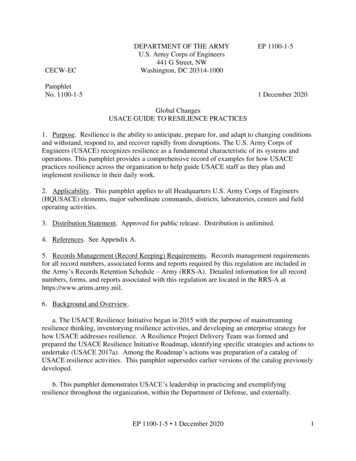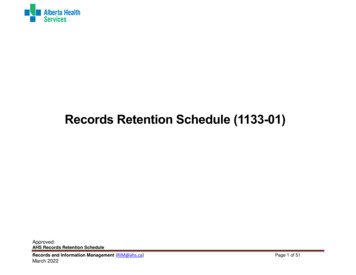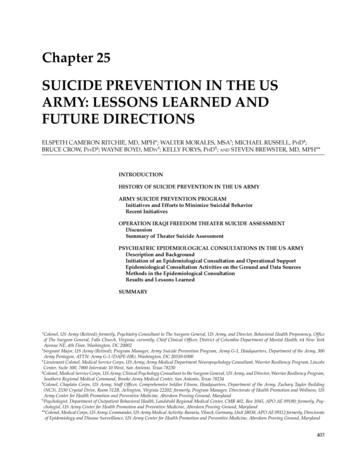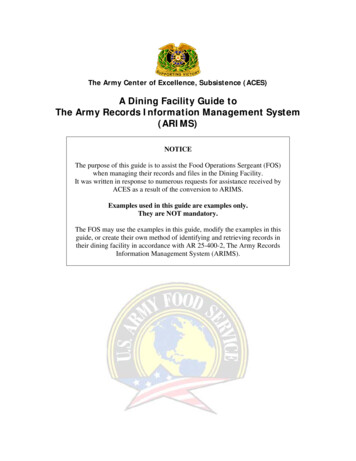
Transcription
DEPARTMENT OF THE ARMYU.S. Army Corps of Engineers441 G Street, NWWashington, DC 20314-1000CECW-ECPamphletNo. 1100-1-5EP 1100-1-51 December 2020Global ChangesUSACE GUIDE TO RESILIENCE PRACTICES1. Purpose. Resilience is the ability to anticipate, prepare for, and adapt to changing conditionsand withstand, respond to, and recover rapidly from disruptions. The U.S. Army Corps ofEngineers (USACE) recognizes resilience as a fundamental characteristic of its systems andoperations. This pamphlet provides a comprehensive record of examples for how USACEpractices resilience across the organization to help guide USACE staff as they plan andimplement resilience in their daily work.2. Applicability. This pamphlet applies to all Headquarters U.S. Army Corps of Engineers(HQUSACE) elements, major subordinate commands, districts, laboratories, centers and fieldoperating activities.3. Distribution Statement. Approved for public release. Distribution is unlimited.4. References. See Appendix A.5. Records Management (Record Keeping) Requirements. Records management requirementsfor all record numbers, associated forms and reports required by this regulation are included inthe Army’s Records Retention Schedule – Army (RRS-A). Detailed information for all recordnumbers, forms, and reports associated with this regulation are located in the RRS-A athttps://www.arims.army.mil.6. Background and Overview.a. The USACE Resilience Initiative began in 2015 with the purpose of mainstreamingresilience thinking, inventorying resilience activities, and developing an enterprise strategy forhow USACE addresses resilience. A Resilience Project Delivery Team was formed andprepared the USACE Resilience Initiative Roadmap, identifying specific strategies and actions toundertake (USACE 2017a). Among the Roadmap’s actions was preparation of a catalog ofUSACE resilience activities. This pamphlet supersedes earlier versions of the catalog previouslydeveloped.b. This pamphlet demonstrates USACE’s leadership in practicing and exemplifyingresilience throughout the organization, within the Department of Defense, and externally.EP 1100-1-5 1 December 20201
USACE staff are encouraged to use the information contained here as resources and examplesfor themselves.FOR THE COMMANDER:JOHN P. LLOYDCOL, ENChief of Staff2EP 1100-1-5 1 December 2020
USACE GUIDE TORESILIENCE PRACTICESCover photographs: Camp Humphreys, South Korea; Walter Washington Convention Center Alternate CareFacility, Washington, D.C.; Portugué s Dam, Puerto Rico; Lake Borgne Surge Barrier, LouisianaEP 1100-1-5 1 December 20203
LEFT BLANK INTENTIONALLY4EP 1100-1-5 1 December 2020
Table of Contents1.0 INTRODUCTION AND BACKGROUND . 71.1 USACE RESILIENCE PRINCIPLES . 71.2 RESILIENCE AREAS OF APPLICATION . 91.3 RESILIENCE-RELATED TERMS AND DEFINITIONS . 102.0 RESILIENCE DRIVERS . 132.1 INTRODUCTION . 132.2 CHRONOLOGY OF DRIVERS FOR INCREASED RESILIENCE . 133.0 RESILIENCE PRACTICES . 213.1 INTRODUCTION . 213.2 USACE RESILIENCE PRACTICES IN CIVIL WORKS. 8Asset Management. 21Beneficial Use of Dredged Material. 22Climate Preparedness & Resilience . 23Critical Infrastructure Protection . 24Dam & Levee Safety Programs . 25Emergency Management . 27Environmental Compliance and Sustainability . 29Environmental Stewardship. 30Floodplain Management Services . 31Hydropower. 32National Flood Risk Management Program . 33Navigation . 34Planning Assistance to States . 36Project Planning. 37Recreation. 38Regulatory . 38Water Supply . 39Water Management . 403.3 USACE RESILIENCE PRACTICES IN MILITARY PROGRAMS . 433.3.13.3.23.3.33.3.43.3.53.3.63.3.73.3.8Control System Cybersecurity . 43Mission Assurance / Defense Critical Infrastructure . 44Environmental Programs . 44International Assistance . 45Installation Energy . 47Master Planning . 48Protective Design . 49Sustainable Buildings . 503.4 USACE RESILIENCE ACTIVITIES IN RESEARCH & DEVELOPMENT . 533.4.13.4.2Civil Works Support . 53Military Programs Support . 554.0 PARTNERSHIPS & FORUMS . 574.1 INTRODUCTION . 574.2 RESILIENCE FORUMS . 57EP 1100-1-5 1 December 20205
4.3 FEDERAL RESILIENCE PARTNERSHIPS . 594.4 OTHER RESILIENCE PARTNERSHIPS . 615.0 FRAMEWORKS, TOOLS & METHODOLOGIES . 635.1 INTRODUCTION . 635.2 MAJOR RESILIENCE ASSESSMENT FRAMEWORKS AND PROGRAMS . 635.3 ADDITIONAL FRAMEWORKS, TOOLS, AND GUIDES . 70APPENDICES . 81APPENDIX A: REFERENCES. 83APPENDIX B: USACE RESILIENCE GUIDANCE. 105APPENDIX C: USACE RESILIENCE EXAMPLES . 1116EP 1100-1-5 1 December 2020
1.0 Introduction and BackgroundThe U.S. Army Corps of Engineers (USACE) defines resilience as the ability to anticipate,prepare for, and adapt to changing conditions and withstand, respond to, and recover rapidlyfrom disruptions. USACE has throughout its history practiced resilience through its diverse andwide-ranging Civil Works and Military Programs missions both at home and abroad. Resiliencethinking is a fundamental enabler for USACE systems and operations to continue to provide theirauthorized services despite changing conditions and disruptions.The USACE Guide to Resilience Practices provides a ‘common operating picture’ of USACEcontributions to resilience. It serves as a benchmark, documenting resilience practices across theorganization and at the project, system, and community levels. Section 2 provides background onmultiple drivers for increased resilience. Section 3 provides examples of initiatives and practicesperformed within different USACE mission areas – Civil Works, Military Programs, andResearch and Development. Section 4 discusses partnerships and forums that USACE has been aparticipant. Section 5 inventories common tools and methodologies used by USACE and others.1.1 USACE Resilience PrinciplesUSACE recognizes four principles ofresilience: Prepare, Absorb, Recover, andAdapt; referred to as the P-A-R-APrinciples (Figure 1.1). Individually, eachprinciple guides actions to improveresilience. Together, the principlesdemonstrate the life cycle needed tomaintain and ensure resilience, establishinga framework for understanding resilienceacross the organization. Detaileddescriptions of each principle are providedin Table 1.1.Figure 1.1 – USACE Resilience PrinciplesTable 1.1 – USACE Resilience Principles: Prepare, Absorb, Recover, and AdaptPrinciplePrepareDescriptionTo prepare is to plan, organize, equip, train, and exercise to build, apply, andsustain the capabilities necessary to prevent, protect against, ameliorate theeffects of, respond to, and recover from damages to life, health, property,livelihoods, ecosystems, and national security.This principle includes all elements needed to be ready before, during, andimmediately after a disruption or changing condition, and to make any changesdeemed necessary. Prepare can include such activities as identifying primarythreats; assessing risks; developing short-term, emergency, and long-termplans; training; and taking necessary actions in support of the developed plans.EP 1100-1-5 1 December 20207
PrincipleAbsorbRecoverAdaptDescriptionPrepare considers all other principles – what is needed to absorb, recover, andadapt.To absorb means to receive a stress or endure change with minimal damageand without loss of normal functionality.Absorb includes actions needed to effectively 'take the punch,' including theimmediate response function. Resilience thinking means to anticipate thedisruption or changing condition occurring at some point, so individualcomponents will withstand, resist, absorb, retreat, flood fight, emergencyresponse, etc., so that the overall impact is absorbed in a prepared fashion andfacilitates the desired recovery priorities.To recover is to return to the previous state of functionality following adisruption or when conditions have changed.This principle includes meeting specific recovery goals, such as communityspecific critical re-openings of schools or community centers within hours ordays post-disruption and, ideally, to build back in a way that allows for lessdamage or disruption from similar future events.To adapt is to adjust built, natural, or social systems in anticipation of or inresponse to a disruption or new condition in a way that leverages beneficialopportunities and/or reduces negative impacts.With increasing uncertainty, interdependence, and risks, all solutions shouldbe adaptable to some extent to be resilient. This includes accepting the currentstate (i.e. accommodating disruption without changing systems); being able tomodify a solution to address the disruption or new condition; or being able totransition to an entirely new solution. This principle includes providing moreadaptive capacity at all levels. Ideally, adaption elements are embedded inactions in each of the other resilience principles.Note, returning to a state of functionality may not necessarily lead to100-percent restoration to pre-disruption conditions, since a community may:(1) be able to recover functionality without all the prior infrastructure; (2) thechanged conditions may be semi-permanent, such as for climate change,indicating that the prior conditions cannot be fully restored; and/or (3) thecommunity has adaptation actions prepared, thus, functionality may shift to thenew areas.8EP 1100-1-5 1 December 2020
1.2 Resilience Areas of ApplicationResilience is often considered undervarying scales and breadths. Forexample, USACE describes differentlevels or “spheres” of resilience as itsareas of application (Figure 1.2). Thesethree main levels of interdependentscales are Project, System, andCommunity. Conceptually, a project iscomprised of multiple components, asystem is composed of multipleprojects, and a community is comprisedof multiple systems. Resilience isapplied differently and has differentconsiderations among each of theseareas. Accordingly, the role USACEplays in each of these areas ofapplication varies.Figure 1.2 – USACE Spheres of ResilienceTable 1.2 – USACE Spheres of Resilience – Project, System, and CommunitySphereProjectResilienceDescriptionA project is one component or group of components designed to serve aspecific function. Examples of a project are a USACE lock and dam, ahospital, a bridge or a power plant.Project resilience is the resilience of an individual project,independent of other projects in the vicinity.SystemResilienceA system is an integrated whole comprised of multiple separable partsthat can be defined geographically, technically, and/or politically, and forUSACE, typically include natural and built environments (USACE2015a).System resilience is the ability of the whole “to withstand a majordisruption within acceptable degradation parameters and to recoverwithin an acceptable time and composite costs and risks.” (Haimes2008).CommunityResilienceA community is a unified group of people who share goals, values orpurposes. It generally functions under the authority of a specificgovernance structure and seeks to strengthen their resilience by workingtogether with numerous partners” (USACE 2017a). A community is madeup of many systems.Community resilience is the manifestation of the resilience of thebuilt, natural, and social systems that make up the community.EP 1100-1-5 1 December 20209
Resilience activities may also be grouped into resilience types to distinguish uniquecharacteristics of what they address. For example, ecosystem resilience relates to natural systemsand within USACE typically refers to aquatic ecosystem restoration and environmental fields.Engineering resilience typically refers to resilient planning, standards, and constructiontechniques. Resilience can also be addressed as targeted initiatives, such as InstallationResilience; Energy Resilience; Infrastructure Systems Resilience; Critical InfrastructureProtection and Resilience; Climate Preparedness and Resilience; and Mission Assurance.1.3 Resilience-Related Terms and DefinitionsIn addition to the terms and definitions discussed above, many other terms are also used atUSACE when referring to resilience. These are discussed in the table below.Table 1.3 – Additional USACE Resilience-Related Terms and s provide a conceptual model and/or an overall construct foranalysis. Guiding frameworks include the P-A-R-A Principles and theUSACE Spheres of Resilience. Frameworks developed by USACE andothers help communities of all sizes and scales better understand theirchallenges, develop possible solutions, and prioritize anticipated threats,changes, and actions in a structured manner.A hazard is a circumstance that increases the likelihood of danger or peril tolife, property, or assets (USACE 2015a).Hazards addressed by USACE typically relate to infrastructure, naturalsystems, and water resources. Discrete occurrences that cause impacts overa relatively short time are often referred to in a number of ways – adverseevent, catastrophic event, disruption, disturbance, emergency, incident, andshock (e.g., hurricane). The terms stress, challenge, and changing conditiontend to describe more slowly evolving impacts (e.g., population shifts,climate change, etc.).Indicator10Danger, risk, and threat can be synonymous with hazard and can be used ineither time-horizon context; however, USACE usually refers to risk as anoutcome of probability and consequences. In common language, a hazardmay also be called a risk.Indicators are parameters for which we can assess magnitudes, extents,and/or trends. For USACE resilience, indicators provide information on thestatus or condition of resilience. Examples of resilience indicators includethe percentage of infrastructure and facilities functioning after a disaster orthe percentage of critical facilities functioning after a disaster. Leadingindicators are also used to proactively assess the state or condition of asystem prior to a potential disruptive event.EP 1100-1-5 1 December 2020
nabilityToolDescriptionMetrics are qualitative or quantitative measurements or systems ofmeasurements (e.g., index) that can be used to detect and assess changes inperformance relative to objectives (USDOI 2015). Resilience often cannotbe measured using a single unit metric or standard as it is dependent onmany threats and can result in multi-dimensional consequences (Haines2009). Metrics generally refer to things that we can measure directly, suchas temperature or humidity.Redundancy is the duplication of critical components of a system with theintention of increasing reliability of the system, usually in the case of abackup or fail-safe.USACE defines resilience as the ability to anticipate, prepare for and adaptto changing conditions and withstand, respond to, and recover rapidly fromdisruptions. Many other definitions are used by other organizations. Thesedefinitions are mostly similar though they are often tailored for specificapplications.Risk is a measure of the probability and consequence of uncertain futureevents and their outcomes. For USACE, risk is woven into every aspect ofthe P-A-R-A principles. Negative outcomes may be mitigated by decreasingthe probability of an undesirable disturbance or reducing the consequenceshould the disturbance occur.Robustness is the ability of a system to continue to operate correctly acrossa wide range of operational conditions with minimal damage, alteration, orloss of functionality, and to fail gracefully outside of that range; the widerthe range of conditions allowing good performance, the more robust thesystem.USACE defines sustainable solutions as solutions that balanceenvironmental, economic, and social impacts to meet present needs withoutsacrificing the ability of future generations to meet their needs.In theory, sustainable solutions are also resilient in that they can withstanddisruptions and continue to function. In practice, USACE pursuessustainability in several tangible ways. To comply with federalrequirements, the agency is subject to mandates to conserve resources,including energy, water, and other items. USACE also implements otherinitiatives that help achieve sustainability including asset management, riskinformed decision making, stakeholder collaboration, and other practices.A tool in the context of USACE resilience is an analysis methodology ormathematical model used to design a component, calculate risk, or measurea particular function. Tools address specific processes and result in discreteoutcomes to support analyses.EP 1100-1-5 1 December 202011
LEFT BLANK INTENTIONALLY12EP 1100-1-5 1 December 2020
2.0 RESILIENCE DRIVERS2.1 IntroductionResilience is not a new concept at USACE although applications have evolved over the years.Among the agency’s earliest missions was the construction of military fortifications and theclearing of waterways for defense. National security strongly depended on resilience measuresprovided by USACE. As an outgrowth of earlier accomplishments and growth of the agency,USACE assumed key roles in ensuring the nation’s economic resilience, initially through itsnavigation mission and later incorporating flood control, hydropower, and other civil works andmilitary missions.This section discusses recent major drivers that have supported resilience and specific mandatesthat have required improvements.2.2 Chronology of Drivers for Increased ResilienceThe following is a chronology of major resilience drivers within USACE, beginning with actionsfollowing Hurricane Katrina in 2005 and continuing through the present day.Hurricane Katrina (2005)Following Hurricane Katrina in 2005, an interagency panel was formed to study failures in theNew Orleans and Southeast Louisiana Hurricane Protection System. The panel determined thatthe “lack of resilience to overtopping significantly increased flooding and resultant losses”. Thepanel emphasized that planning and design methods must also be more systems-based, allowinggreater analyses for how structures work alongside other measures to ensure performance of theentire system. This included greater consideration of enhanced natural environments “to dealwith the dynamics of climate, demographics, and social and economic well-being”. (IPET 2008).USACE initiated the Actions for Change (AFC) program in 2006, due in part to lessons learnedfrom Hurricane Katrina. The AFC program laid out a comprehensive systems approach intendedin part to “review and recommend policies, methods, and technologies to champion adaptivemanagement, responses to dynamic temporal and spatial system changes that introduceuncertainty and reduce resilience ”.In 2007, the AFC program specifically addressed resilience in the context of climate changethrough the Responses to Climate Change (RCC) program. RCC’s goals included betterunderstanding of responses to dynamic temporal and spatial system changes, to increase theagency’s ability to manage uncertainties affecting systems and to improve resilience inunforeseen circumstances.Lessons learned from Hurricane Katrina were applied in the planning and design of the 14 billion Greater New Orleans Hurricane and Storm Damage Risk Reduction System. USACEworked very closely with communities through public meetings, briefings, workshops, anddiscussions with business leaders. These engagements sought to ensure that residual risk, rolesand responsibilities and community resilience needs beyond the system were communicated andEP 1100-1-5 1 December 202013
understood. Inundation maps, other risk communication tools and the evaluation of resilienceplanning played a significant part in the success of this collaborative approach.Presidential Policy Directive (PPD) No. 8, National Preparedness (2011)Presidential Policy Directive PPD-8, National Preparedness, issued by the Executive Office ofthe President (EOP), aims at “strengthening the security and resilience of the United Statesthrough systematic preparation for the threats that pose the greatest risk to the security of theNation, including acts of terrorism, cyber-attacks, pandemics, and catastrophic natural disasters.”PPD-8 defines resilience as “the ability to adapt to changing conditions and withstand andrapidly recover from disruption due to emergencies.” (EOP 2011a).PPD-8 directs federal departments and agencies to work with whole communities to develop anational preparedness goal and a series of frameworks and plans related to reaching the goal. TheDepartment of Homeland Security (DHS) / Federal Emergency Management Agency (FEMA)was tasked to coordinate this effort, resulting in the following components: The National Preparedness Goal was established as “a secure and resilient nation with thecapabilities required across the whole community to prevent, protect against, mitigate,respond to, and recover from the threats and hazards that pose the greatest risk.” The goalidentifies 32 core capabilities necessary to prepare for specific types of incidents.Examples of capabilities include operational coordination; threats and hazardsidentification; infrastructure systems; economic recovery; natural and cultural resources;and community resilience. The National Preparedness System outlines an organized process for the nation to moveforward with preparedness activities. National Planning Frameworks define how agencies work together to best meet theNational Preparedness Goal. Frameworks have been developed for each of fivepreparedness mission areas: National Prevention Framework; National ProtectionFramework; National Mitigation Framework; National Response Framework; andNational Disaster Recovery Framework. An annual National Preparedness Report documents the progress made toward achievingthe goal. Federal Interagency Operations Plans to demonstrate how federal efforts can worktogether to support state and local plans. A comprehensive coordinated effort to build and sustain national preparedness.Hurricane Sandy (2012)Following Hurricane Sandy in 2012, USACE prepared together with the National Oceanic andAtmospheric Administration (NOAA) a set of Infrastructure Systems Rebuilding Principles(NOAA and USACE 2013). The primary objective of the principles was to “help rebuild moreresilient and sustainable coastal communities that can adapt to and better mitigate the impacts ofcoastal hazards.” USACE subsequently issued a technical guide entitled Coastal Risk Reductionand Resilience: Using the Full Array of Measures, outlining how the agency reduces risks andimproves resilience through an integrated approach, drawing from an array of coastal measures.14EP 1100-1-5 1 December 2020
In 2015, USACE released the North Atlantic Coast Comprehensive Study (NACCS), identifyingregional opportunities to increase resilience in high risk areas (USACE 2015a). The study builton previous lessons learned and brought to bear the latest scientific information available forstate, local and tribal planners. NACCS included a Coastal Risk Management Framework toserve as a common approach for identifying risks and determining coastal management strategiesand measures. NACCS also identified nine specific coastal areas warranting further analysesthrough individual feasibility studies and environmental impact statements.Executive Order (EO) 13636, Improving Critical Infrastructure Cybersecurity andPPD-21, Critical Infrastructure Security and Resilience (2013)Executive Order 13636 and PPD-21 set forth national policy to strengthen the security andresilience of critical infrastructure against evolving threats and hazards. Recognizing that criticalinfrastructure must be secure and able to withstand and rapidly recover from all hazards,EO 13636 and PPD-21 called for an updated and overarching national framework that reflectsthe increasing role of cybersecurity in securing physical assets. PPD-21 advances a national unity of effort to strengthen and maintain secure,functioning, and resilient critical infrastructure – including assets, networks, and systems– that are vital to public confidence and the nation's safety, prosperity and well-being. EO 13636 promulgates the integration of physical and cyber security planning and directsthe federal government to coordinate with critical infrastructure owners and operators toimprove information sharing and collaboratively develop and implement risk-basedapproaches to cybersecurity.As an owner and operator of a large portfolio of infrastructure, USACE is actively developingand implementing an integrated physical and cybersecurity risk management framework toaddress physical and cyber vulnerabilities. (EOP 2013a, 2013b).U.S. Army Energy Security & Sustainability (ES2) Strategy (2015)The U.S. Army released a strategic roadmap to future energy security and sustainability calledthe Energy Security and Sustainability (ES2) Strategy. This document is intended to foster amore adaptable and resilient force, and prepare for a future defined by complexity, uncertaintyand rapid change. The strategy outlines five goals: inform decisions, optimize use, assure access,build resilience and drive innovation. The document emphasizes energy and includes recognitionof water and land as equally essential resources. (U.S Army 2015a).Assistant Secretary of the Army Installations, Energy & Environment Strategy 2025 (2015and 2016)The Office of the Assistant
for all record numbers, associated forms and reports required by this regulation are included in the Army's Records Retention Schedule -Army (RRS-A). Detailed information for all record numbers, forms, and reports associated with this regulation are located in the RRS-A at https://www.arims.army.mil. 6. Background and Overview. a.










